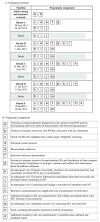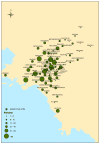Design and baseline findings of a large-scale rapid response to an HIV outbreak in people who inject drugs in Athens, Greece: the ARISTOTLE programme
- PMID: 26032121
- PMCID: PMC4854521
- DOI: 10.1111/add.12999
Design and baseline findings of a large-scale rapid response to an HIV outbreak in people who inject drugs in Athens, Greece: the ARISTOTLE programme
Abstract
Aims: To (i) describe an intervention implemented in response to the HIV-1 outbreak among people who inject drugs (PWIDs) in Greece (ARISTOTLE programme), (ii) assess its success in identifying and testing this population and (iii) describe socio-demographic characteristics, risk behaviours and access to treatment/prevention, estimate HIV prevalence and identify risk factors, as assessed at the first participation of PWIDs.
Design: A 'seek, test, treat, retain' intervention employing five rounds of respondent-driven sampling.
Setting: Athens, Greece (2012-13).
Participants: A total of 3320 individuals who had injected drugs in the past 12 months.
Intervention: ARISTOTLE is an intervention that involves reaching out to high-risk, hard-to-reach PWIDs ('seek'), engaging them in HIV testing and providing information and materials to prevent HIV ('test') and initiating and maintaining anti-retroviral and opioid substitution treatment for those testing positive ('treat' and 'retain').
Measurements: Blood samples were collected for HIV testing and personal interviews were conducted.
Findings: ARISTOTLE recruited 3320 PWIDs during the course of 13.5 months. More than half (54%) participated in multiple rounds, resulting in 7113 visits. HIV prevalence was 15.1%. At their first contact with the programme, 12.5% were on opioid substitution treatment programmes and the median number of free syringes they had received in the preceding month was 0. In the multivariable analysis, apart from injection-related variables, homelessness was a risk factor for HIV infection in male PWIDs [odds ratio (OR) yes versus no = 1.89, 95% confidence interval (CI) = 1.41, 2.52] while, in female PWIDS, the number of sexual partners (OR for > 5 versus one partner in the past year = 4.12, 95% CI = 1.93, 8.77) and history of imprisonment (OR yes versus no = 2.76, 95% CI = 1.43, 5.31) were associated with HIV.
Conclusions: In Athens, Greece, the ARISTOTLE intervention for identifying HIV-positive people among people who inject drugs (PWID) facilitated rapid identification of a hidden population experiencing an outbreak and provided HIV testing, counselling and linkage to care. According to ARISTOTLE data, the 2011 HIV outbreak in Athens resulted in 15% HIV infection among PWID. Risk factors for HIV among PWID included homelessness in men and history of imprisonment and number of sexual partners in women.
Keywords: HIV outbreak; PWIDs; intervention; prevalence; respondent-driven sampling; risk factors.
© 2015 Society for the Study of Addiction.
Conflict of interest statement
None.
Figures


References
-
- Nikolopoulos G, Paraskevis D, Hatzakis A. HIV epidemiology in Greece. Future Microbiol. 2008;3:507–16. - PubMed
-
- Hellenic Center for Disease Control and Prevention. HIV/AIDS Surveillance Report in Greece. 26. Athens: Dec 31, 2011. 2011, Available at: http://www.keelpno.gr.
-
- Paraskevis D, Nikolopoulos G, Tsiara C, Paraskeva D, Antoniadou A, Lazanas M, et al. HIV-1 outbreak among injecting drug users in Greece, 2011: a preliminary report. Euro Surveill. 2011;16 pii=19962. - PubMed
-
- Greek Reitox Focal Point. Annual report. 2011 Available at: http://www.ektepn.gr/
Publication types
MeSH terms
Grants and funding
LinkOut - more resources
Full Text Sources
Other Literature Sources
Medical
Miscellaneous

